Smith Tower
Introduction
Text-to-speech Audio
Construction of this historic Seattle skyscraper began in 1911 and was completed three years later, with the Neoclassical terracotta skyscraper reaching a height of 484 feet. The building offers breathtaking panoramic views of the city from its observation deck, and it also holds a historic visitor center along with ground-level shopping and leasable office space on the remaining floors. The construction of Smith Tower reflected the city's growth and shaped Pioneer Square’s history.
Images
Smith Tower and Mt. Rainier
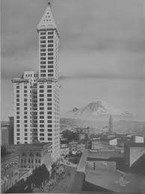
Smith Tower Construction
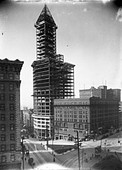
Smith Tower and Downtown
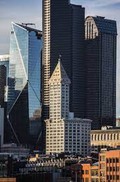
Smith Tower and Pioneer Square
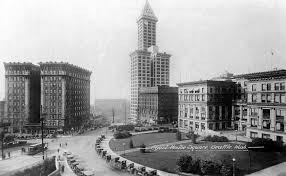
Modern Smith Tower
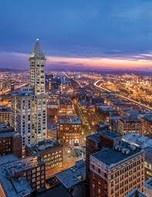
Backstory and Context
Text-to-speech Audio
Smith Tower’s construction in 1911 and its grand opening in 1914 demonstrated Seattle’s ambitions to become one of America's most significant cities as it was one of the tallest buildings in the country at the time of its completion. It was also the tallest skyscraper west of Ohio at the time. The building remains a Pioneer Square landmark with its pyramid-topped skyscraper.
While the tower was built in Seattle, its architecture was inspired by the buildings in New York City and Chicago. Architect Lyman C. Smith and his son Burns Lyman Smith were originally from New York and visited Seattle for the first time in 1888. Demonstrating the increasing interest in building advancements and real estate opportunities in the Pacific Northwest. Burns was then later sold eight different properties along Pioneer Square in the 1890’ from a local Seattle real estate agent: J.W. Clise. Smith planned to build one of the tallest skyscrapers in the country, but another wealthy businessman, John Hoge, was also planning a similar feat. The Seattle Times reported on the two men's rivalry to build the grandest skyscrapers: “They sparred with each other about their plans, each wanting to build a little higher than the other, but both agreed finally that 14 stories was about the right height." The Hoge Building ultimately grew to 18 stories.
Burns Smith studied construction and architecture in New York City and then returned to Seattle where he solidified his plan to construct a building so tall that it would remain the tallest, at least in his lifetime. After his father's death in 1910, Burns Smith decided his skyscraper would be no less than 42 stories tall. After completed construction, the Smith Tower ended up only having 38 floors.
Smith Tower’s purpose was to transition Seattle’s original business district from Yesler Way to Pioneer Square, with one goal being to increase the value of Burns Smith’s seven other properties along Pioneer Square. Smith Tower centered Seattle’s business center, but its expenses were substantial and Burns Smith sold the building ten years later. Smith Tower was sold another dozen times before being acquired by Ivar Haglund in the 1970s. The Samis Land Company bought the building in 1996 and invested around twenty-seven million dollars into updating the interior. As of 2021, Smith Tower is owned and operated by Unico Properties who acquired the building in 2015 with plans to renovate the building.
Sources
Bush, Evan. Seattle’s Smith Tower: a historic timeline, SeattleTimes.com. June 4th 2004. Accessed April 21st 2022. https://www.seattletimes.com/seattle-news/seattles-smith-tower-a-historic-timeline/.
Pastier, John. Smith Tower (Seattle), HistoryLink.org. July 1st 2004. Accessed April 21st 2022. https://www.historylink.org/File/4310 .
Sherrard, J. SEATTLE NOW & THEN: BEFORE SMITH TOWER, 1908, Seattle Now and Then. March 11th 2021. Accessed April 21st 2022. https://pauldorpat.com/2021/03/11/seattle-now-then-before-smith-tower-1908/.
Smith Tower, SmithTower.com. Accessed April 21st 2022. https://www.smithtower.com.
